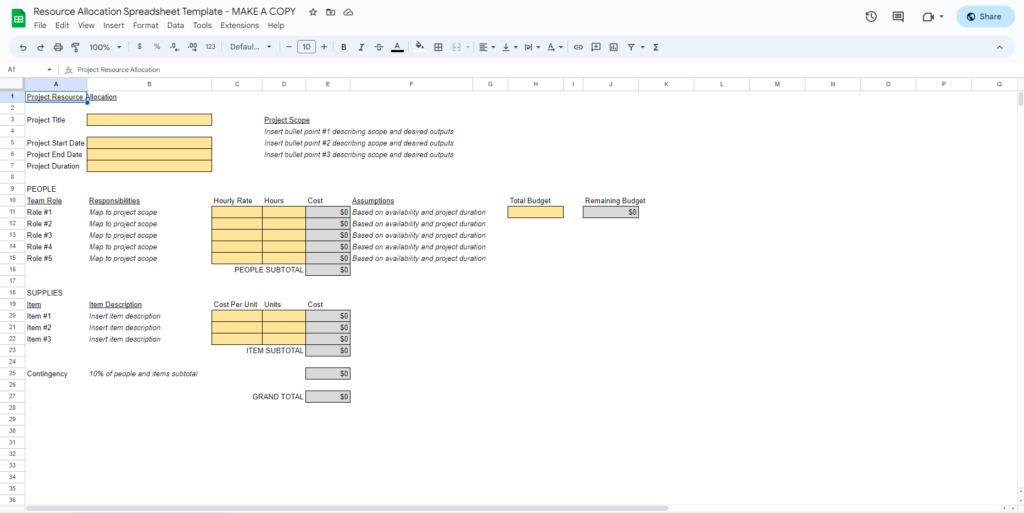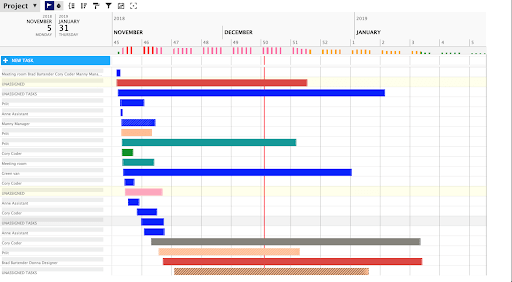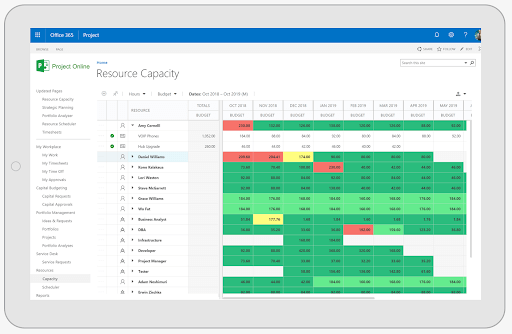You've completed your project plan, and now you need to plan and secure the team members to work on it. You also need to balance your plan against the budget and scope of the project—you need a resource management plan.
What Is A Resource Management Plan?
A resource management plan is a strategy for how resources will be allocated, scheduled, and used during the project life cycle.
The plan outlines which specific resources are needed, in what quantities, and when they are needed in order to fulfill the project scope.
Resources include anything that is essential to completing the project—human resources (i.e. team members), physical resources like meeting rooms, and time and materials.
What Is A Resource Management Plan For?
Resource management plans serve a few critical functions on projects and facilitate:
- Accessibility: Project team members, as well as project and resource managers can edit and revise parts of the resource plan.
- Transparency: Resource management plans allow every project manager in an organization to see what is going on and schedule resources based on other manager’s plans and their own needs. They're also used to keep track of information such as the whereabouts of equipment or team member status.
- Accuracy: Project management plans and resource plans should be updated in real-time, so project managers have up-to-date and accurate information when making decisions.
Resource Management Plan Template [Download]

This allocation spreadsheet will make it easy to keep track of hourly rates for your team members and associated costs. It's in a Google Sheets format, but you can easily import a copy in Excel, if you prefer. Just select File and then either "Make a copy" or "Download."
What To Include In A Resource Management Plan
These are the essential elements to include in your resource management plan.
1. Responsibility Assignments
Using something like a RACI chart to identify resources and their roles in a project or organization makes assigning deliverables and responsibilities clear and easy-to-understand for all stakeholders.
Employees and managers can also use project management software to estimate the duration of a specific task, assign specific roles, and generate a manageable schedule.
2. Resource Estimates
Include your estimates for who and how many team members you'll need for a project. Start by asking yourself these questions:
- What needs to be done?
- Do we have enough people?
- Who is the manager in charge?
- Do we need to hire someone?
- Do our people have the right skill sets?
- Do we need to outsource?
3. Resource Management Charts
Duration and histogram charts help you and your project team get a better picture of how the resources you're planning to use fit the schedule. Histograms assist project managers with flagging and resolving problems with overallocation before they become issues.
4. Project Dependencies
A project dependency occurs when a team member can't complete their tasks without the completion of a prior task or another resource.
A resource dependency occurs when a task requires one specific team member to complete, but that person is not available. If a task can be completed by multiple team members, it is not resource dependent.
5. Alternatives
Selecting alternative methods, plans, and technologies is always important when putting together a resource management plan.
Having multiple alternatives can positively influence your costs, timeline, and the reliability of the project. These alternative approaches can be reviewed and stitched together for the most efficient resource planning.
Why Are Resource Management Plans Important?
Resource management plans are important for the following reasons.
1. More Accurate Project Timelines
Including a detailed timeline helps take the guesswork out of the project timeline and provides an accurate project schedule for managers and teams to measure milestones and project progress.
This helps project managers set expectations that are favorable to the stakeholders and clients.
2. Increased Employee And Team Satisfaction
By quantifying the work an employee is able to do, project managers can make better, strategic decisions regarding who takes part in a project and when. This results in a more realistic and manageable workload for team members.
Team members can easily become overworked just as resources can be overused. This can have long-term side effects: stress at work can affect sleep, health, and overall job satisfaction.
With effective resource management, project managers can pinpoint where a project is lacking and provide more insight into whether the “resource pool” is sufficient or whether to bring on a temporary hire.
3. Accurate Resource Estimates
Resource management plans make sure companies and businesses are effectively using the resources that they have and creating a balanced workload.
With a good resource management plan, project estimates become easier to come up with. Project managers are able to break down where resources are needed in terms of associated costs and allocated budget, and then better calculate costs and project margins.
4. Improved Project Flow
A resource management plan provides transparent information to all stakeholders, which improves accountability and keeps team members informed on what they are working on and when. This speeds up transitions between project phases.
5. Improved Transparency & Communication
Project resource management plans solve some of the most common challenges in resource management, including:
- Projects competing for resources
- Lack of communication on roles and responsibilities
- Misalignment with team capacity or resource availability
Keeping resource management plans accessible to all project managers and team members in an organization ensures everyone has an overview of current resource usage and that everyone is working from the same information when resolving conflicts.
How To Create A Resource Management Plan
Follow these key steps for creating a resource management plan.
- Review your budget & scope: This will give you an idea of what and how many resources you'll need (ex. do you need developers and/or designers, and how many of each). You'll also probably start to get an idea of which specific team members you'll want (ex. a senior designer over a more junior one).
- Check who's available: See what other projects are on your team member's plates, and what kind of time they might have available to contribute to this new project. If you want to put your senior designer on the project, but they're tied up with something else, you'll need to have a back-up plan.
- Match resources to tasks: Start allocating team members to specific tasks based on their availability and skill sets. You might need to get creative if the team is busy. If your web designer doesn't have enough capacity for a project that involves a website design, you might ask a less-specialized designer to start it, and then have your web designer review once their plate clears.
- Add time estimates: Go over the plan at a high-level with your chosen team members, and ask them to give you a rough time estimate for the work you're planning to assign to them. Consult the statement of work or project plan to see if estimates have been provided in those documents.
- Check utilization: Make sure you haven't given too much or too little work to anyone. Aim to fill about 70 to 80% of a team member's day with project work so you're not overloading them (they still need time for meetings and other admin in their day).
- Document the plan & keep monitoring: Record your plan in an spreadsheet or shared document (preferably in resource management software). Monitor utilization, capacity, and progress throughout the project. It's a given that things will change, and the more you're on top of it, the less it will impact the success of the project.
Resource Management Plan Examples
Resource management plans are specific documents found in various forms, usually within a software application or Excel doc.
Gantt Chart Resource Plan
Here's an example of what your resource plan might look like as a Gantt chart. Rather than having task names along the vertical axis, you'll use team member names instead. The bars represent which tasks team members will be working on, usually measured in days.

Spreadsheet Resource Plan
Another example is the spreadsheet below. This is a similar approach to what's used in our allocation spreadsheet in the template section. Here, you track team member hours and hourly rates, which allows you to see how you're tracking against budget.

This can help you with decision-making about which team members will work on the project and on which tasks (ex. you might opt for a designer with a cheaper hourly rate for smaller budget projects).
Resource Management Plan Best Practices
Here are a few best practices to use when creating your resource management plan.
1. Consider Budget
If resources are essentially unlimited on your project, you can allocate resources to tasks with an emphasis on “getting it done,” rather than being stingy with resources to conserve budget.
If your project budget is tighter, you'll need to allocate tasks to resources, and use a more conservative approach to resource allocation. You'll also need to keep a closer eye on utilization. There are a variety of utilization metrics that are useful in understanding whether resources are fully optimized.
2. Keep Past Resource Plan Data To Analyze
Saving data from previous or similar projects aids project resource planning for future projects. Previous data should be recorded and analyzed, including changes made, reallocation of resources, tasks, and time spent.
3. Use Resource Management Software
Proper resource management software tools offer more accessibility and collaboration for the whole team. Managers need to constantly update in real-time, and spreadsheets may or may not always be the best option for larger teams.
Tools For Resource Planning
Incorporating resource allocation software can also assist with some of the common challenges of resource planning by:
- Allowing for in-app communication in order to keep track of team communication and changes made to plans
- Providing real-time updates and changes
- Saving your company from having to incorporate custom charts or expensive ERPs
Here's my list of the best resource management software to help you start your search:
What's Next?
Have more questions about resource management plans? Join the conversation in Slack with 100s of other digital project managers with DPM Membership!


